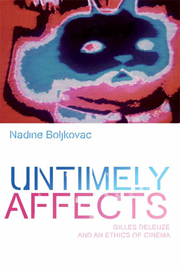3 - From Depths and Ashes
Published online by Cambridge University Press: 05 September 2013
Summary
The skin has at its disposal a vital and properly superficial potential energy.
(LS: 103)A philosophy of the surface and of the event is always caught in a struggle with violent and destructive mixtures of bodies; it is always trying to give sense to a life of violent shocks, invasions and punctures.
(Williams 2008a: 84)It is not the other which is another I, but the I which is an other, a fractured I. There is no love which does not begin with the revelation of a possible world as such, enwound in the other which expresses it.
(DR: 261)she It's extraordinary how beautiful your skin is.
(Duras 1961: 25)Ashes, limbs, a haunting refrain. The pulsating woodwinds, strings and piano of the score commence. As they persist, title credits for Resnais' 1959 Hiroshima mon amour appear and fade; an image surfaces. This visual image, a networked matrix of lines with offshoots branching in various directions, as might a stitched scar, evokes a rhizomatic surfacing upon an unknown surface, a mysterious formation perceived against a strangely agitating soundtrack. Image and score finally fade to a momentary black silence. Then, as writes Marguerite Duras, ‘we see mutilated bodies – the heads, the hips – moving – in the throes of love or death – and covered successively with the ashes, the dew, of atomic death – and the sweat of love fulfilled’ (1961: 8).
- Type
- Chapter
- Information
- Untimely AffectsGilles Deleuze and an Ethics of Cinema, pp. 61 - 90Publisher: Edinburgh University PressPrint publication year: 2013



